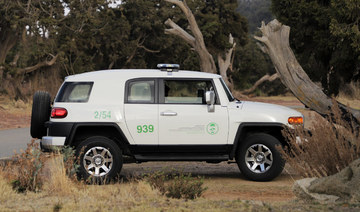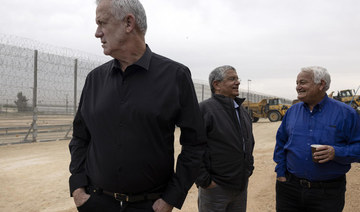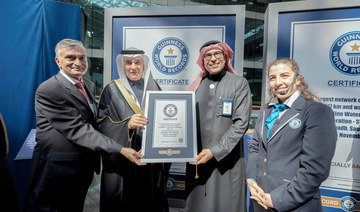DUBAI: In better times, Ukrainian drone enthusiasts flew their gadgets into the sky to photograph weddings, fertilize soybean fields or race other drones for fun.
Now some are risking their lives by forming a volunteer drone force to help their country repel the Russian invasion.
“Kyiv needs you and your drone at this moment of fury!” read a Facebook post late last week from the Ukrainian military, calling for citizens to donate hobby drones and to volunteer as experienced pilots to operate them.
One entrepreneur who runs a retail store selling consumer drones in the capital said its entire stock of some 300 drones made by Chinese company DJI has been dispersed for the cause. Others are working to get more drones across the border from friends and colleagues in Poland and elsewhere in Europe.
“Why are we doing this? We have no other choice. This is our land, our home,” said Denys Sushko, head of operations at Kyiv-based industrial drone technology company DroneUA, which before the war was helping to provide drone services to farmers and energy companies.
Sushko fled his home late last week after his family had to take cover from a nearby explosion. He spoke to The Associated Press by phone and text message Friday after climbing up a tree for better reception.
“We try to use absolutely everything that can help protect our country and drones are a great tool for getting real-time data,” said Sushko, who doesn’t have a drone with him but is providing expertise. “Now in Ukraine no one remains indifferent. Everyone does what they can.”
Unlike the much larger Turkish-built combat drones that Ukraine has in its arsenal, off-the-shelf consumer drones aren’t much use as weapons — but they can be powerful reconnaissance tools. Civilians have been using the aerial cameras to track Russian convoys and then relay the images and GPS coordinates to Ukrainian troops. Some of the machines have night vision and heat sensors.
But there’s a downside: DJI, the leading provider of consumer drones in Ukraine and around the world, can easily pinpoint the location of an inexperienced drone operator, and no one really knows what the Chinese firm might do with that data. That makes some volunteers uneasy. DJI declined to discuss specifics about how it has responded to the war.
“DJI makes its products entirely for civilian use, and we deplore any use of our products to cause harm,” company spokesperson Adam Lisberg said by email. “However, just like the manufacturers of pickup trucks or mobile phones, we are unable to control how they are ultimately used.”
Taras Troiak, a dealer of DJI drones who started the Kyiv retail store, said DJI has been sending mixed signals about whether it’s providing preferential access to — or disabling — its drone detection platform AeroScope, which both sides of the conflict can potentially use to monitor the other’s flight paths and the communication links between a drone and the device that’s controlling it. In the meantime, Ukrainian drone experts said they’ve been doing whatever they can to teach operators how to protect their whereabouts.
“There are a number of tricks that allow you to increase the level of security when using them,” Sushko said.
Sushko said many in the industry are now trying to get more small drones — including DJI alternatives — transported into Ukraine from neighboring European countries. They can also be used to assist search-and-rescue operations.
Ukraine has a thriving community of drone experts, some of whom were educated at the National Aviation University or the nearby Kyiv Polytechnic University and went on to found local drone and robotics startups.
“They’ve got this homebuilt industry and all these smart people who build drones,” said Faine Greenwood, a US-based consultant on drones for civic uses such as disaster response.
Troiak’s DJI-branded store in Kyiv, which is now shuttered as city residents take shelter, was a hub for that community because it runs a maintenance center and hosts training sessions and a hobby club. Even the country’s president, Volodymyr Zelenskyy, once paid a visit to the store to buy a drone for one of his children, Troiak said.
A public drone-focused Facebook group administered by Troiak counts more than 15,000 members who have been trading tips about how to assist Ukrainian troops. One drone photographer who belongs to the Ukrainian Association of Drone Racing team told The Associated Press he decided to donate his DJI Mavic drone to the military rather than try to fly it himself. He and others asked not to be named out of fear for their safety.
“The risk to civilian drone operators inside Ukraine is still great,” said Australian drone security expert Mike Monnik. “Locating the operator’s location could result in directed missile fire, given what we’ve seen in the fighting so far. It’s no longer rules of engagement as we have had in previous conflicts.”
Some in Ukraine’s drone community already have experience deploying their expertise in conflict zones because of the country’s long-running conflict with Russian-backed separatists in eastern Ukraine. Monnik’s firm, DroneSec, has tracked multiple instances just in the past year of both sides of that conflict arming small drones with explosives. One thing that Ukrainians said they’ve learned is that small quadcopter drones, such as those sold at stores, are rarely effective at hitting a target with explosive payloads.
“It would seem somewhat short-sighted to waste one,” said Greenwood, the consultant based in Cambridge, Massachusetts. “I assume the chief goal would be recon. But if things are getting desperate, who knows.”
DJI also has experience in responding to warfighters trying to weaponize its drones and used so-called “geofencing” technology to block drone movements during conflicts in Syria and Iraq. It’s not clear yet if it will do the same in Ukraine; even if it does, there are ways to work around it. But its rival US-based drone company Skydio, without mentioning DJI by name, warned this week that “Russia and its allies — including China — could force technology companies subject to their laws to suspend operation or to provide intelligence on Ukrainian forces.”
The California company said it has not previously sold products in Ukraine but is now looking at getting some in the hands of Ukraine’s defense forces.
Small civilian drones are no match against Russian combat power but will likely become increasingly important in a protracted war, leaving drone-makers no option to be completely neutral. Any action they take or avoid is “indirectly taking a side,” said PW Singer, a New America fellow who wrote a book about war robots.
“We will see ad-hoc arming of these small civilian drones much the way we’ve seen that done in conflicts around the world from Syria to Iraq and Yemen and Afghanistan,” Singer said. “Just like an IED or a Molotov cocktail, they won’t change the tide of battle but they will definitely make it difficult for Russian soldiers.”
Ukrainian drone enthusiasts sign up to repel Russian forces
https://arab.news/6xwtn
Ukrainian drone enthusiasts sign up to repel Russian forces
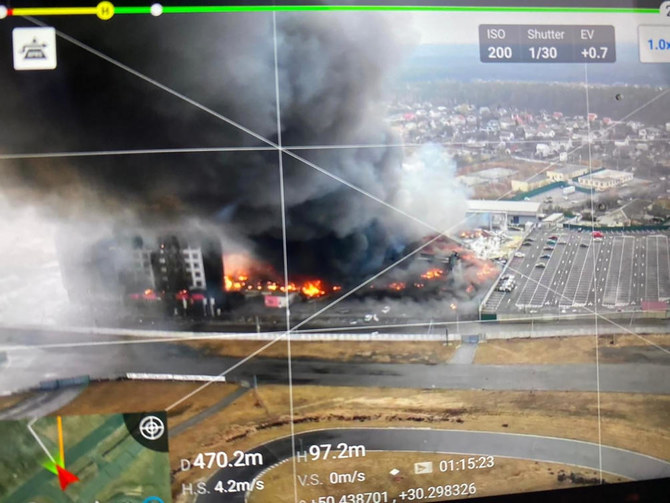
- Now some are risking their lives by forming a volunteer drone force to help their country repel the Russian invasion
- “Kyiv needs you and your drone at this moment of fury!” read a Facebook post late last week from the Ukrainian military
A Nigerian chess champion is trying to break the world record for the longest chess marathon
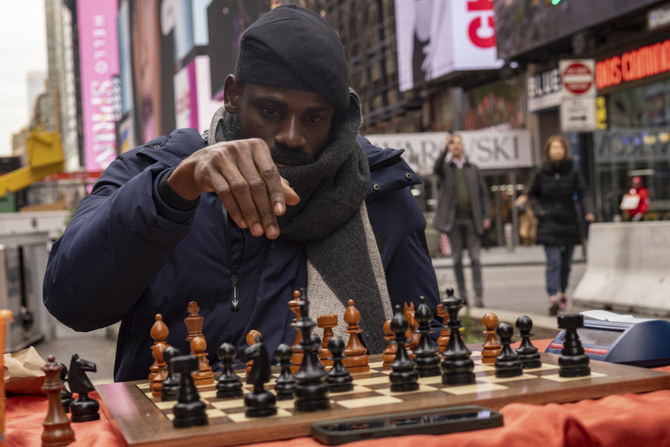
- Tunde Onakoya, 29, is playing against Shawn Martinez, an American chess champion, in line with Guinness World Record
- Onakoya, who founded Chess in Slums Africa, hopes to raise $1 million for children’s education across Africa
NEW YORK: A Nigerian chess champion and child education advocate is attempting to play chess nonstop for 58 hours in New York City’s Times Square to break the global record for the longest chess marathon.
Tunde Onakoya, 29, hopes to raise $1 million for children’s education across Africa. He is playing against Shawn Martinez, an American chess champion, in line with Guinness World Record guidelines that any attempt to break the record must be made by two players who would play continuously for the entire duration.
Onakoya had played chess for 42 hours by 10:00 a.m. GMT on Friday. Support is growing online and at the scene, where a blend of African music is keeping onlookers and supporters entertained amid cheers and applause.
The current chess marathon record is 56 hours, 9 minutes and 37 seconds, achieved in 2018 by Hallvard Haug Flatebø and Sjur Ferkingstad, both from Norway.
The record attempt is “for the dreams of millions of children across Africa without access to education,” said Onakoya, who founded Chess in Slums Africa in 2018. The organization wants to support education of at least 1 million children in slums across the continent.
“My energy is at 100 percent right now because my people are here supporting me with music,” Onakoya said Thursday evening after the players crossed the 24-hour mark.
On Onakoya’s menu: Lots of water and jollof rice, one of West Africa’s best known dishes.
For every hour of game played, Onakoya and his opponent get only five minutes’ break. The breaks are sometimes grouped together, and Onakoya uses them to catch up with Nigerians and New Yorkers cheering him on. He even joins in with their dancing sometimes.
A total of $22,000 was raised within the first 20 hours of the attempt, said Taiwo Adeyemi, Onakoya’s manager.
“The support has been overwhelming from Nigerians in the US, global leaders, celebrities and hundreds of passersby,” he said.
Onakoya’s attempt is closely followed in Nigeria where he regularly organizes chess competitions for young people living on the streets to boost his cause. More than 10 million children are out of school in the West African country — one of the world’s highest rates.
Among those who have publicly supported him are celebrities and public office holders, including Nigeria’s former Vice President Yemi Osinbajo, who wrote to Onakoya on X, formerly Twitter: “Remember your own powerful words: ‘It is possible to do great things from a small place.’“
The Guinness World Record organization has yet to publicly comment about Onakoya’s attempt, which could reach 58 hours by midnight on Friday. It sometimes takes weeks for the organization to confirm any new record.
Used missiles for sale: Iranian weapons used against Israel are up for grabs on Jordan-based website
Used missiles for sale: Iranian weapons used against Israel are up for grabs on Jordan-based website

- Debris used in attack listed on OpenSooq online marketplace
LONDON: Fragments of missiles launched by Iran during the recent attack on Israel have been discovered for sale on Jordan’s prominent OpenSooq website, which is known for trading goods, including vehicles and real estate.
Al Arabiya reported on Sunday that the shrapnel was being advertised, with pieces described as “Used Iranian ballistic missile in good condition for sale,” and “One-time use ballistic missile for sale at an attractive price.”
The sellers had provided specifications and images of the missiles, describing them as “excellent type,” and mentioned their involvement in an “accident” resulting in “severe damage to the body.”
Some listings even included installment payment options.
Iran launched drones and missiles toward Israel late on Saturday as it retaliated following a suspected Israeli strike on the consulate annex building adjacent to the Iranian Embassy in Damascus, Syria, earlier this month.
While most projectiles were intercepted by a joint response from Israel, the US, UK, France, and Jordan, the attack marked Iran’s first direct military assault on Israeli territory, escalating tension and uncertainty in the region.
Following the attack, individuals shared photographs online showing debris that had fallen on Jordanian territory in areas such as Al-Hasa, Marj Al-Hamam, and Karak Governorate.
The Jordanian government confirmed that it had intercepted some flying objects in its airspace, with no reported damage or injuries.
Debris from such incidents often holds economic value. Metal debris from the Iraq War has been used by Iran-backed groups to finance their activities.
Similar items are sold online as military memorabilia, and there has been a surge in demand for such artifacts, as seen in Australia last year, preceding the country’s ban on the sale of hate symbols.
Google Doodle celebrates Lebanese-American poet and artist Etel Adnan

- Etel Adnan rose to fame for her 1977 novel Sitt Marie Rose about the Lebanese civil war
DUBAI: Google released its latest Doodle on Monday honoring Etel Adnan, a Lebanese-American poet, essayist and visual artist, considered one of the most accomplished Arab-American authors of her era.
The poet, who rose to fame for her 1977 novel Sitt Marie Rose about the Lebanese civil war, was born in Lebanon in 1925 to a Greek mother and a Syrian father, and grew up in multiple cultures, languages, nationalities and religions. Sitt Marie Rose won the France-Pays Arabes award and become a classic of war literature, so much so that it is taught in American classrooms.
In 1949, Adnan went to Paris to study philosophy at the Sorbonne before going to America to study at Harvard and Berkeley.
From 1958 to 1972, she taught philosophy in California, during which time she also started painting and writing poetry. She developed her literary voice in English and said abstract painting was the entry point into her native Arabic.
Adnan returned to Beirut, where from 1972 to 1976 she worked as the arts editor for two newspapers. She returned to California in 1979, then spent her later years living between Paris and Beirut.
In 2003, Adnan was named “arguably the most celebrated and accomplished Arab American author writing today” by the academic journal MELUS: Multi-Ethnic Literature of the United States.
Adnan’s most recent honor was in 2020. Her poetry collection “Time,” which is a selection of her work — translated from French by Sarah Riggs — won the Griffin Poetry Prize.
The King Abdulaziz Center for World Culture, or Ithra, earlier this year opened an eponymous exhibition in her honor – “Etel Adnan: Between East and West” – showcasing 41 of her works. The space at Ithra’s gallery is the first solo exhibition of Adnan’s work in Saudi Arabia, running until June 30.
The works on display span from the beginning of Adnan’s artistic career in the late 1950s through to her final creations in 2021, shortly before her death that year aged 96.
Some of the works are on loan from significant international institutions such as the Sharjah Art Foundation, Sfier-Semler Gallery and Sursock Museum. Some are part of private collections.
‘HELP’ written in palm fronds lands rescue for Pacific castaways

- The trio became stranded on Pikelot Atoll, a tiny island in the remote Western Pacific, after their motor-powered skiff malfunctioned
- A US Navy aircraft saw the "help" sign and a ship came later to rescue the stranded trio, all experienced mariners in their 40s
LOS ANGELES: Sometimes all you have to do is ask for “HELP“: That’s what three men stranded on a deserted Pacific island learned earlier this week, writing the message in palm fronds which were spotted by US rescuers.
The trio, all experienced mariners in their 40s, became stranded on a lonely island after setting off from Micronesia’s Polowat Atoll on March 31 in their motor-powered skiff which subsequently experienced damage.
They were reported missing last Saturday by a woman who told the US Coast Guard her three uncles never returned from Pikelot Atoll, a tiny island in the remote Western Pacific.
“In a remarkable testament to their will to be found, the mariners spelled out ‘HELP’ on the beach using palm leaves, a crucial factor in their discovery,” said search and rescue mission coordinator Lt. Chelsea Garcia.
She reported that the trio was discovered Sunday on Pikelot Atoll by a US Navy aircraft.
“This act of ingenuity was pivotal in guiding rescue efforts directly to their location,” she said.
The aircraft crew dropped survival packages, and rescuers one day later dropped a radio which the mariners used to communicate that they were in good health, had access to food and water, and that the motor on their 20-foot (six-meter) skiff was no longer working.
On Tuesday morning a ship rescued the trio and their equipment, returning them to Polowat Atoll, the Coast Guard said.
In August 2020, three Micronesian sailors also stranded on Pikelot were rescued after Australian and US warplanes spotted a giant “SOS” they had scrawled on the beach.
Dining hall with Trojan War decorations uncovered in ancient Roman city of Pompeii

- One fresco depicts Paris and Helen, whose love affair caused the Trojan War, according to classical accounts
- Pompeii and the surrounding countryside was submerged by volcanic ash when Mount Vesuvius exploded in AD 79
ROME: A black-walled dining hall with 2,000-year-old paintings inspired by the Trojan War has been discovered during excavations at the Roman city of Pompeii, authorities said on Thursday.
The size of the room — about 15 meters long and 6 meters wide — the quality of the frescoes and mosaics from the time of Emperor Augustus, and the choice of characters suggest it was used for banquets, Pompeii Archaeological Park said.

“The walls were painted black to prevent the smoke from the oil lamps being seen on the walls,” Gabriel Zuchtriegel, head of the park, said.
“People would meet to dine after sunset, and the flickering light of the lamps had the effect of making the images appear animated, especially after a few glasses of good Campanian wine.”
Pompeii and the surrounding countryside was submerged by volcanic ash when Mount Vesuvius exploded in AD 79, killing thousands of Romans who had no idea they were living beneath one of Europe’s biggest volcanoes.
The site has seen a burst of archaeological activity aimed at halting years of decay and neglect, largely thanks to a 105-million-euro ($112 million) European Union-funded project.

The dominant theme of the newly discovered paintings is heroism and fate.
One fresco depicts Paris and Helen, whose love affair caused the Trojan War, according to classical accounts. Another one shows doomed prophetess Cassandra and the Greco-Roman god Apollo.
According to Greek mythology, Cassandra predicted the Trojan War after receiving the gift of foresight from Apollo, but no-one believed her. This was because of a curse Apollo put upon her for refusing to give herself to him.



